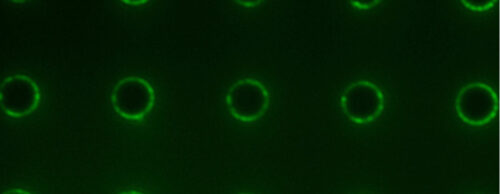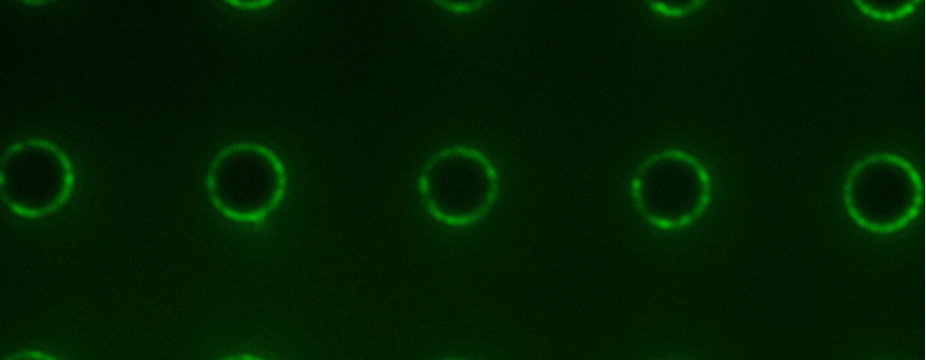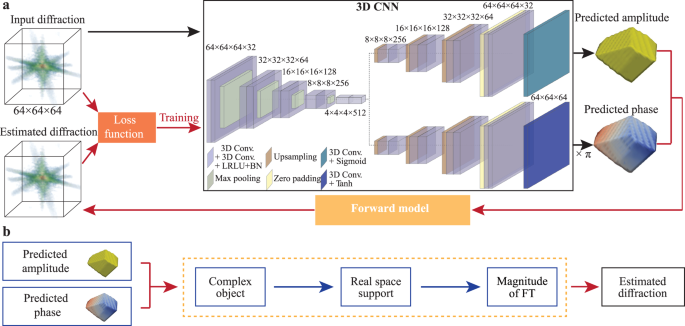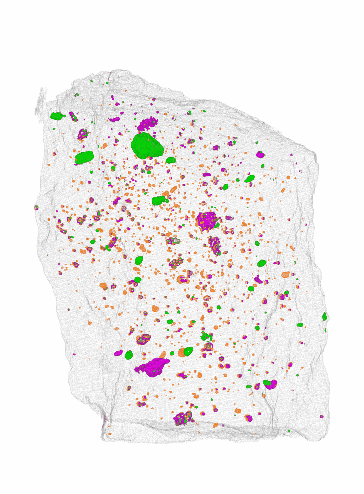病気の診断や環境モニタリングに役立つ化合物を検出する新しい検査法を開発 New test detects compounds for disease diagnostics, environmental monitoring
2022-11-02 ハーバード大学

Fluorescence image of amphiphiles concentrated at the edges of micropillars on a microstructured surface. (Image courtesy of the Aizenberg Lab/Harvard SEAS)
新しいテストは、微細構造の表面上で液滴を転がすことで超低濃度の両親媒性化合物を検出することができる。
研究チームは、この技術を使って、水中の病原性両親媒性エンドトキシンの濃度を検出することを実証した。
この微細構造表面は、何千もの円形のマイクロピラーで構成されており、自己組織化したロングテール分子で均一にコーティングされているため、マイクロピラーの端の部分を除いて、摩擦のない滑らかな界面を形成している。このとき、コーティングに隙間ができてしまう。液滴が表面を転がるとき、両親媒性分子がなければ、穴の部分にぶつかり、乱れた縁の摩擦に打ち勝つことができずに止まってしまう。
しかし、両親媒性分子を多く含む液滴は転がり続ける。両親媒性分子は尾の長い分子と一緒になって表面の隙間を埋め、転がり続ける。エンドトキシンの場合、両親媒性分子が表面に沈着すると、液滴中の他の両親媒性分子と結合し、より大きな化合物を形成し、最終的には液滴の速度を低下させ、停止させる。液滴が表面上で停止する位置によって、その液滴が補修した穴の数、つまり両親媒性分子の濃度がわかる。
研究者らはまた、濃度の異なる両親媒性化合物が、構造化表面とどのように相互作用するかを予測するモデルも開発した。さらに、構造化表面のサイズ、形状、柱間の距離、分子コーティングを変えることにより、特定の種類の両親媒性化合物を特定の濃度で検出できるよう表面を調整することができた。
<関連情報>
- https://www.seas.harvard.edu/news/2022/11/seeing-concentrations-toxins-naked-eye
- https://www.pnas.org/doi/10.1073/pnas.2211042119
自己組織化単分子膜の無秩序領域への直接注入による両親媒性化合物の濡れ性を利用した超高感度検出 Wettability-based ultrasensitive detection of amphiphiles through directed concentration at disordered regions in self-assembled monolayers
Yuxing Yao, Robert K. A. Bennett, Yang Xu, Adil M. Rather, Shucong Li, Tung Chun Cheung, Alisha Bhanji, Michael J. Kreder, Dan Daniel , Solomon Adera, Joanna Aizenberg and Xiaoguang Wang
Proceedings of the National Academy of Science Published: October 17, 2022
DOI:https://doi.org/10.1073/pnas.2211042119
Significance
Wettability-based molecular detection is emerging to enable portable and fast chemical detection within droplets. However, current detection methods can only respond to changes in a droplet’s bulk wetting properties, leading to poor detection limits. We report a design principle that overcomes this fundamental limitation by locally concentrating analytes within a droplet’s contact line to modulate the local surface roughness, which further affects droplet mobility. This mechanism enables the detection of molecules even at minute concentrations where droplets’ bulk wetting properties are unchanged. This design can be implemented to functional surface devices that can readily sort microliter aqueous droplets into discrete groups with different amphiphile concentrations and molecular sizes, which have potential for early disease diagnostics and environmental water quality monitoring.
Abstract
Various forms of ecological monitoring and disease diagnosis rely upon the detection of amphiphiles, including lipids, lipopolysaccharides, and lipoproteins, at ultralow concentrations in small droplets. Although assays based on droplets’ wettability provide promising options in some cases, their reliance on the measurements of surface and bulk properties of whole droplets (e.g., contact angles, surface tensions) makes it difficult to monitor trace amounts of these amphiphiles within small-volume samples. Here, we report a design principle in which self-assembled monolayer–functionalized microstructured surfaces coated with silicone oil create locally disordered regions within a droplet’s contact lines to effectively concentrate amphiphiles within the areas that dominate the droplet static friction. Remarkably, such surfaces enable the ultrasensitive, naked-eye detection of amphiphiles through changes in the droplets’ sliding angles, even when the concentration is four to five orders of magnitude below their critical micelle concentration. We develop a thermodynamic model to explain the partitioning of amphiphiles at the contact line by their cooperative association within the disordered, loosely packed regions of the self-assembled monolayer. Based on this local analyte concentrating effect, we showcase laboratory-on-a-chip surfaces with positionally dependent pinning forces capable of both detecting industrially and biologically relevant amphiphiles (e.g., bacterial endotoxins), as well as sorting aqueous droplets into discrete groups based on their amphiphile concentrations. Furthermore, we demonstrate that the sliding behavior of amphiphile-laden aqueous droplets provides insight into the amphiphile’s effective length, thereby allowing these surfaces to discriminate between analytes with highly disparate molecular sizes.




